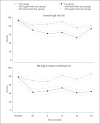A randomized clinical trial of anticaries therapies targeted according to risk assessment (caries management by risk assessment)
- PMID: 22472515
- PMCID: PMC3362266
- DOI: 10.1159/000337241
A randomized clinical trial of anticaries therapies targeted according to risk assessment (caries management by risk assessment)
Abstract
This randomized parallel group clinical trial assessed whether combined antibacterial and fluoride therapy benefits the balance between caries pathological and protective factors. Eligible, enrolled adults (n = 231), with 1-7 baseline cavitated teeth, attending a dental school clinic were randomly assigned to a control or intervention group. Salivary mutans streptococci (MS), lactobacilli (LB), fluoride (F) level, and resulting caries risk status (low or high) assays were determined at baseline and every 6 months. After baseline, all cavitated teeth were restored. An examiner masked to group conducted caries exams at baseline and 2 years after completing restorations. The intervention group used fluoride dentifrice (1,100 ppm F as NaF), 0.12% chlorhexidine gluconate rinse based upon bacterial challenge (MS and LB), and 0.05% NaF rinse based upon salivary F. For the primary outcome, mean caries increment, no statistically significant difference was observed (24% difference between control and intervention groups, p = 0.101). However, the supplemental adjusted zero-inflated Poisson caries increment (change in DMFS) model showed the intervention group had a statistically significantly 24% lower mean than the control group (p = 0.020). Overall, caries risk reduced significantly in intervention versus control over 2 years (baseline adjusted generalized linear mixed models odds ratio, aOR = 3.45; 95% CI: 1.67, 7.13). Change in MS bacterial challenge differed significantly between groups (aOR = 6.70; 95% CI: 2.96, 15.13) but not for LB or F. Targeted antibacterial and fluoride therapy based on salivary microbial and fluoride levels favorably altered the balance between pathological and protective caries risk factors.
Copyright © 2012 S. Karger AG, Basel.
Figures



Comment in
-
Non-fluoride caries-preventive agents.J Dent Hyg. 2012 Summer;86(3):163-7. Epub 2012 Aug 27. J Dent Hyg. 2012. PMID: 22947838 No abstract available.
-
The combined use of chlorhexidine and fluoride therapy can reduce the risk for dental caries.J Evid Based Dent Pract. 2013 Sep;13(3):123-4. doi: 10.1016/j.jebdp.2013.07.015. J Evid Based Dent Pract. 2013. PMID: 24011013
Similar articles
-
Understanding treatment effect mechanisms of the CAMBRA randomized trial in reducing caries increment.J Dent Res. 2015 Jan;94(1):44-51. doi: 10.1177/0022034514555365. Epub 2014 Oct 29. J Dent Res. 2015. PMID: 25355774 Free PMC article. Clinical Trial.
-
Effectiveness of 2-year application of school-based chlorhexidine varnish, sodium fluoride gel, and dental health education programs in high-risk adolescents.Quintessence Int. 2008 Feb;39(2):e45-51. Quintessence Int. 2008. PMID: 18560640 Clinical Trial.
-
Mother and youth access (MAYA) maternal chlorhexidine, counselling and paediatric fluoride varnish randomized clinical trial to prevent early childhood caries.Int J Paediatr Dent. 2012 May;22(3):169-79. doi: 10.1111/j.1365-263X.2011.01188.x. Epub 2011 Oct 17. Int J Paediatr Dent. 2012. PMID: 21999806 Free PMC article. Clinical Trial.
-
The role of chlorhexidine in caries prevention.Oper Dent. 2008 Nov-Dec;33(6):710-6. doi: 10.2341/08-3. Oper Dent. 2008. PMID: 19051866 Review.
-
[Individual risk assessment of caries].Ned Tijdschr Tandheelkd. 1992 Jun;99(6):209-12. Ned Tijdschr Tandheelkd. 1992. PMID: 11820133 Review. Dutch.
Cited by
-
Counseling on Early Childhood Caries transmission by dentists.J Public Health Dent. 2013 Spring;73(2):151-7. doi: 10.1111/j.1752-7325.2012.00356.x. Epub 2012 Sep 13. J Public Health Dent. 2013. PMID: 22970775 Free PMC article.
-
Restorative treatment thresholds for proximal caries in dental PBRN.J Dent Res. 2012 Dec;91(12):1202-8. doi: 10.1177/0022034512464778. Epub 2012 Oct 9. J Dent Res. 2012. PMID: 23053847 Free PMC article.
-
At the crossroads of oral health inequities and precision public health.J Public Health Dent. 2020 Mar;80 Suppl 1(Suppl 1):S14-S22. doi: 10.1111/jphd.12316. Epub 2019 May 7. J Public Health Dent. 2020. PMID: 31063590 Free PMC article. Review.
-
Caries risk assessment by Caries Management by Risk Assessment (CAMBRA) Protocol among the general population of Pakistan-a multicenter analytical study.PeerJ. 2024 Jan 31;12:e16863. doi: 10.7717/peerj.16863. eCollection 2024. PeerJ. 2024. PMID: 38313036 Free PMC article.
-
Caries Management by Risk Assessment: Results from a Practice-Based Research Network Study.J Calif Dent Assoc. 2019 Jan;47(1):15-24. J Calif Dent Assoc. 2019. PMID: 30853771 Free PMC article. Clinical Trial.
References
-
- Bader JD, Perrin NA, Maupome G, Rindal B, Rush WA. Validation of a simple approach to caries risk assessment. J Public Health Dent. 2005;65:76–81. - PubMed
-
- Bader JD, Shugars DA, Bonito AJ. A systematic review of selected caries prevention and management methods. Community Dent Oral Epidemiol. 2001;29:399–411. - PubMed
-
- Billings RJ, Meyerowitz C, Featherstone JD, Espeland MA, Fu J, Cooper LF, Proskin HM. Retention of topical fluoride in the mouths of xerostomic subjects. Caries Res. 1988;22:306–310. - PubMed
-
- Bohning D, Dietz E, Schlattmann P, Mendonca L, Kirchner U. The zero-inflated Poisson model and the decayed, missing and filled teeth index in dental epidemiology. J R Statist Soc A. 1999;162:195–209.
-
- Chauncey HH, Glass RL, Alman JE. Dental caries. Principal cause of tooth extraction in a sample of US male adults. Caries Res. 1989;23:200–205. - PubMed
Publication types
MeSH terms
Substances
Grants and funding
LinkOut - more resources
Full Text Sources
Medical

